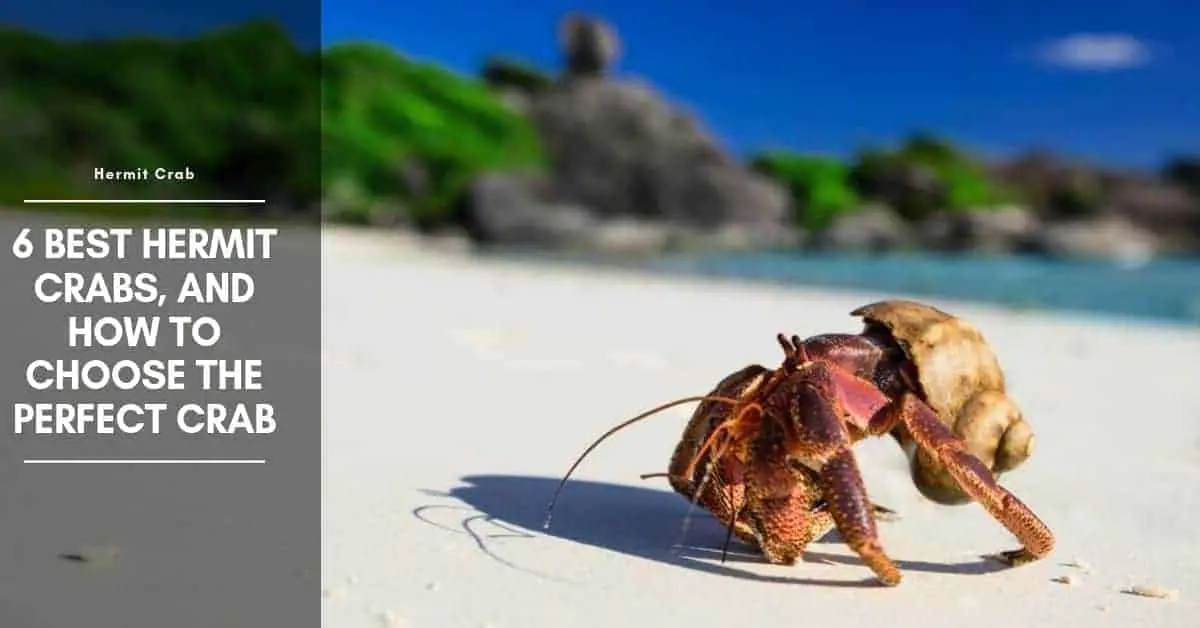While Hermit Crabs are very easy to care for, they are living creatures that DO NEED a very specific environment in order to survive. If you can’t supply this type of environment, then your Hermit Crabs won’t be happy and they will most likely die. I’m not trying to deter you from owning a few of these awesome little creatures. I just want to make sure you fully understand what you are getting into.
6 Types of Hermit Crabs
If you want to get hermit crab for your tank, there are a few hermit crabs you can consider.
1. Purple Pincher Hermit Crab (Caribbean hermit crab)
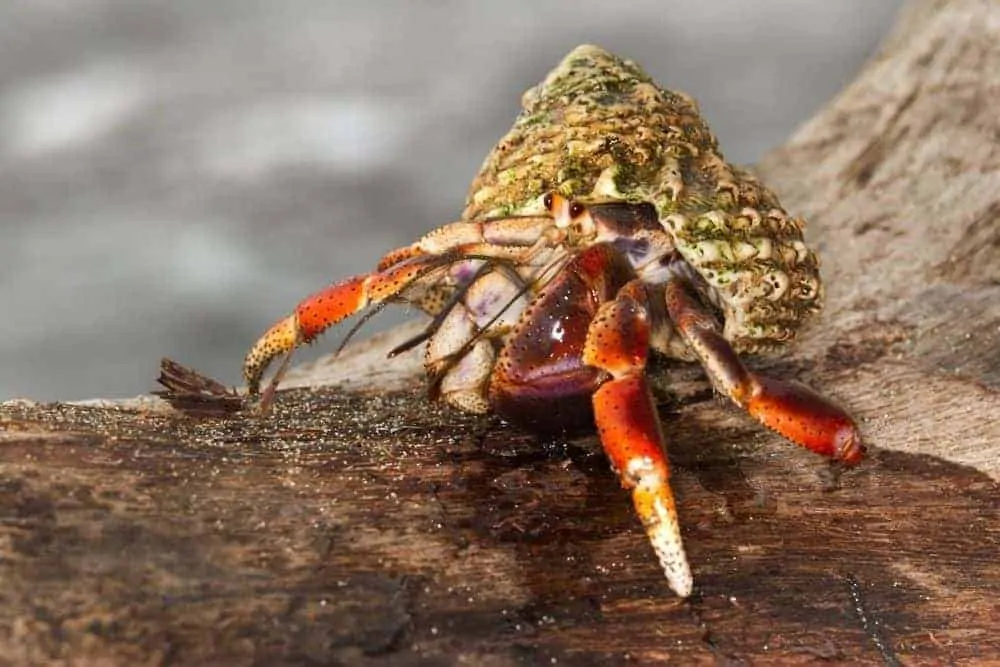
This is by far the most common type of Hermit Crab on the market today. There is a really good chance that your crabs will be Purple pinchers and that is a good thing because they are very easy to care for. They make great pets and they have a very interesting social life. You will find yourself spending hours watching them go about their nightly routines. Some people, myself included fall in love with their beautiful colors. The Purple Pincher is also known as the Caribbean Crab because that is where they are naturally found.
The overall temperament of the Purple Pincher is very good and they are a little slower than most species. They get along great with people and of course, they like to be around more of their own kind but they have been known to fight over shells. If a Purple Pincher sees another in a shell it likes, it will grab the shell and rock it back and forth until the defending crab abandons it. Sometimes the crab defending its shell will make a loud chirp noise. These skirmishes are rarely a problem but they can turn deadly.
2. Ecuadorian Hermit Crab (Coenobita Compressus)
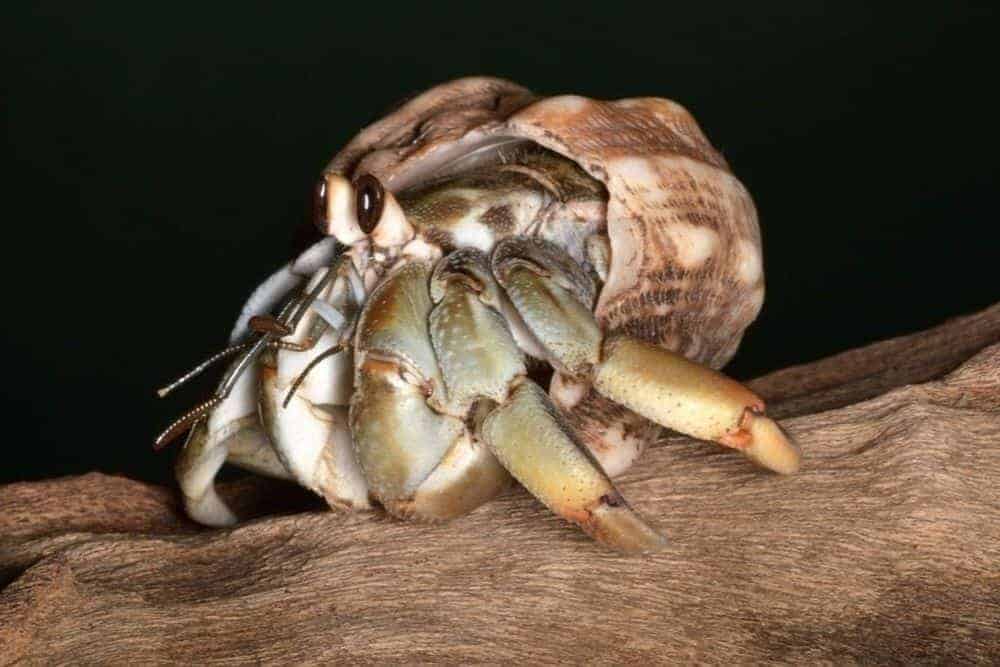
The Ecuadorian Hermit Crab is one of the smallest Hermit Crabs on the market and they are known to be very fast! You would be surprised at how quick these little crabs can move.
They will often prefer to use a smaller shell that might look as if it won’t fit. Using a smaller shell allows them to move more quickly. Ecuadorian Hermit Crabs would prefer to run away where as a Purple Pincher might be more apt to close up and hide inside its shell.
The colors of this species varies. They can be green, orange, bright blue, yellow, tan or orange. These colors will change as the crab grows and molts. You will also notice that these Hermit Crabs are very busy. They are always doing something even during daylight hours and they will often communicate with each other by chirping.
Ecuadorian Hermit Crabs are often very skittish around people and some of them have been known to be aggressive. They are also known for creating deep tunnels and climbing anything in their habitat. Because they are so fast and such good climbers, it is very important to make sure your habitat is secure. They have been known to escape.
These are the two most common types of Hermit Crabs found in the pet industry. There are a few other species that are starting to show up as well.
3. Strawberry Hermit Crabs
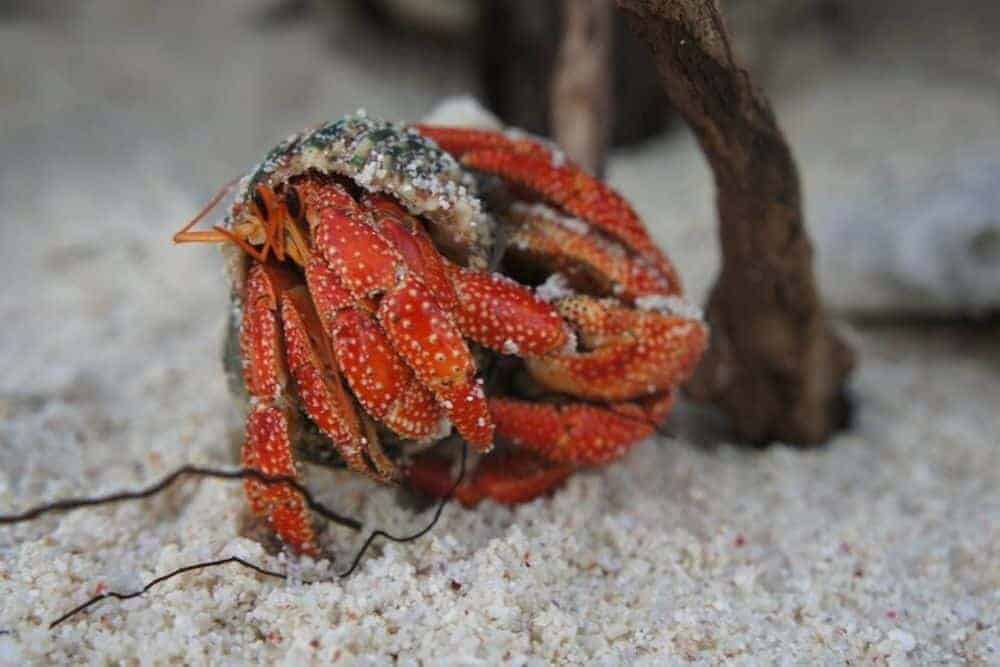
Can you guess why this species of Hermit Crab is called “Strawberry?” Could it be their vibrant red color? Well, of course! You will also find some that have more of an orange tint to them. Strawberry Hermit Crabs are also the only land species to have what is referred to as an “opalescent” sheen. Their exoskeletons appear to show multiple colors at different angles.
Strawberries are one of the most active Hermit Crab species and will spend most of their time moving about their habitat. They love to dig and require a good amount of substrate depth in order to be happy. Strawberries are also known to be somewhat fragile and difficult to care for.
Tetra AquaSafe Plus, 8.45 Ounces, aquarium Water Conditioner And Dechlorinator, Model Number: 46798162681
$8.49 (as of July 13, 2024 11:01 GMT +03:00 - More infoProduct prices and availability are accurate as of the date/time indicated and are subject to change. Any price and availability information displayed on [relevant Amazon Site(s), as applicable] at the time of purchase will apply to the purchase of this product.)API TAP WATER CONDITIONER Aquarium Water Conditioner 16-Ounce Bottle
(as of July 13, 2024 06:40 GMT +03:00 - More infoProduct prices and availability are accurate as of the date/time indicated and are subject to change. Any price and availability information displayed on [relevant Amazon Site(s), as applicable] at the time of purchase will apply to the purchase of this product.)API STRESS COAT Aquarium Water Conditioner 4-Ounce Bottle (85B)
40% Off4. Blueberry Hermit Crab (Coenobita Purpureus)
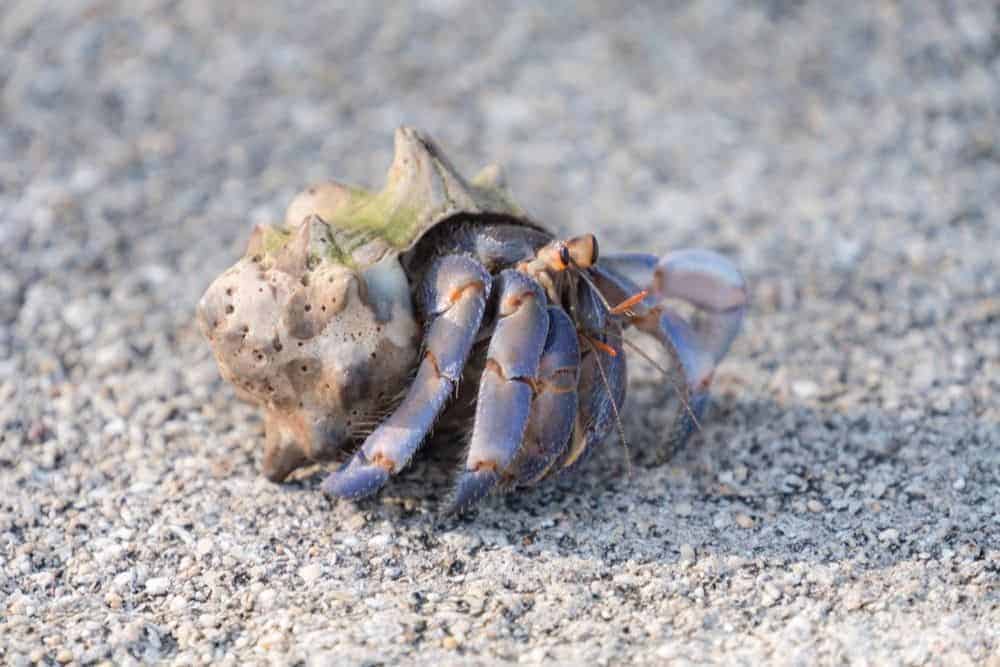
Yet another Hermit Crab aptly named for its beautiful colors. If you guessed that these Hermit Crabs are more of a blue color, you would be 100% correct. This species of Hermit Crab is rarely seen in pet stores.
5. Australian land hermit crab
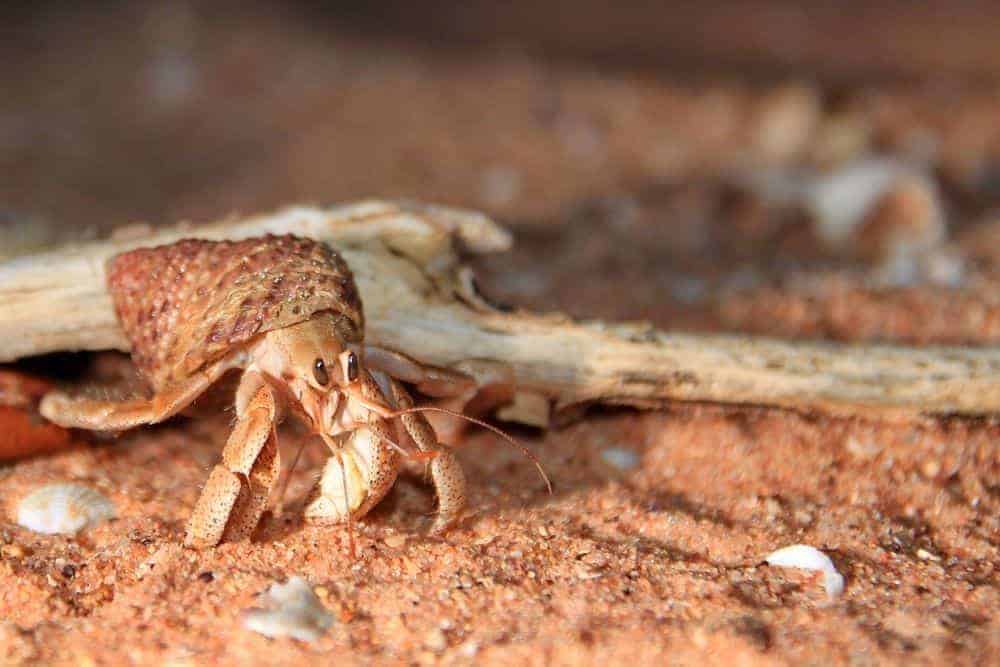
The native Australian Hermit Crab is most likely only going to be found in Australia. Who would have thought? They vary widely in color but are most often white or brown. Good on ya mate!
6. Ruggie Hermit Crab (Coenobita Rugosus)
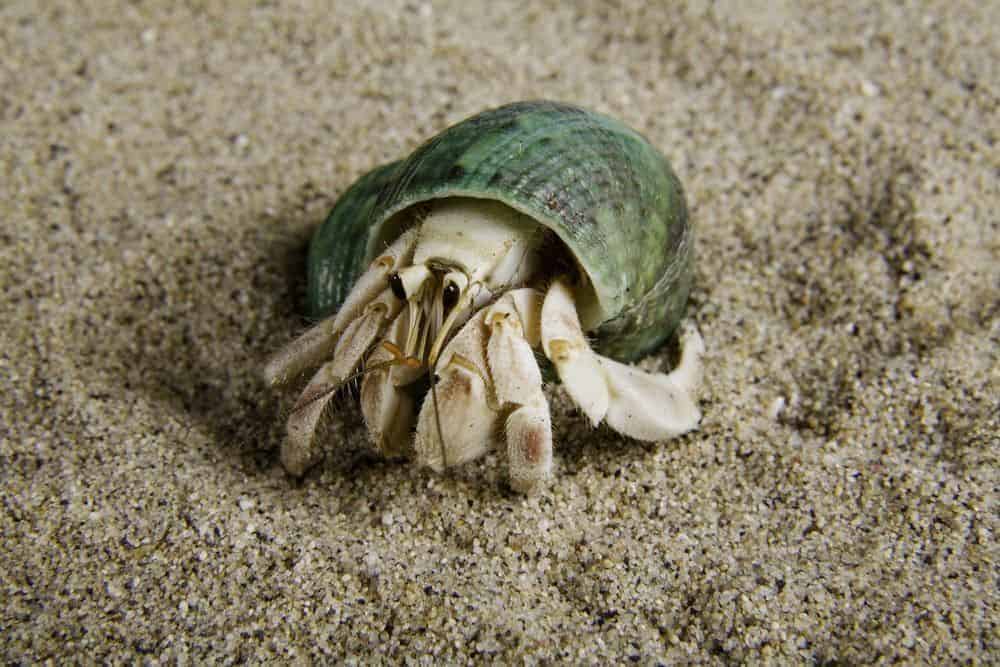
Last but definitely not least, we have the Ruggie Hermit Crabs. These Hermit Crabs are also a little on the rare side. You will most likely only find them on the Internet. They vary widely in color and are known to be very mellow crabs. These Hermit Crabs are not recommended for first-time crab keepers.
Hermit Crab Lifespan
There is a very common misconception about the lifespan of a Hermit Crab. If you create a good environment for these little creatures, they will live a long time. How long? Some species can live well over 25 years. Don’t think that owning Hermit Crabs will be a short venture. You can expect years of fun with these little creatures.
Now that you know a little more information about the various species of Hermit Crabs, let’s take a closer look at actually buying and choosing your first Hermit Crabs.
Choosing the Perfect Hermit Crabs
You basically have only two choices when it comes to purchasing your new Hermit Crabs. You can purchase them online or you can pay a visit to your local pet store and see what is in stock. Some people might think about scouring the beach and collecting a few Hermit Crabs from the wild. Don’t do this! Not only is this a bad idea, but it is also illegal in some locations.
Should You Purchase Your Hermit Crabs Online?
Purchasing any type of pet online can be a little tricky for several reasons.
- You will be paying more for high shipping charges. Shipping any type of live animal is going to be expensive.
- Animals, including Hermit Crabs, tend to get very stressed when shipped. In some cases, they die.
- You have no way of knowing the condition of the Hermit Crabs before shipment. This is not good!
There is really only one positive reason for ordering Hermit Crabs online and that one reason is getting a better selection. Online vendors will have more exotic crabs in stock. This might be the only way to obtain certain species.
If you have chosen to avoid the online Hermit Crab market – (A really good idea) – then you only have one option left. You will need to take a trip to your local pet store. Here is what you need to pay close attention to once you arrive!
Take a look at the overall condition of the entire pet store. The first bad clue is usually a foul smell. Pet stores that don’t properly clean animal habitats will smell like urine or feces. If your pet store smells like this, you may want to choose another one.
If the pet store passes “The Smell Test,” then you should take a look at all of the animals in the store, not just the Hermit Crabs. Again, just use your best judgment to determine whether or not the pet store is properly taking care of their animals.
Look at all the habitats. Do they appear clean? Is there fresh food and water? Do the animals look happy and healthy? These are all very important questions you should be asking yourself before you approach the Hermit Crabs. Once you locate the crabs, here’s what you should be looking for.
Active Crabs are Healthy Crabs
The first sign of a healthy Hermit Crab is an active Hermit Crab, but this can tricky to determine. Hermit Crabs are nocturnal and most pet stores are closed at night so the Hermit Crabs will most likely be sleeping. This makes it difficult to determine if a crab is actually healthy or not.
You might need to wake the crab up. This can be done by picking up the Hermit Crab. Most Hermit Crabs are very curious. Once you pick them up, they will want to see what is going on.
Avoid Hermit Crabs With Painted Shells
Painted shells might look cute but they can be extremely toxic. Hermit Crabs like to eat just about anything they can get a hold of, this includes the chipping paint on a painted shell. Most paints have enough toxic materials to kill a Hermit Crab with just a little nibble.
Don’t Choose Hermit Crabs Without Shells
Hermit Crabs rarely leave their shells. In fact, their shells are their only line of defense. A Hermit Crab that chooses to walk around without a shell is not well.
Avoid Crabs With Mites
Some Hermit Crabs attract mites. These little pests will eventually kill a Hermit Crab. These mites are tiny and very difficult to see but they DO NOT like direct sunlight. If you can take your Hermit Crab choices out into the sunshine, you will be able to see the mites scatter.
Hermit Crab Habitats Must Be Free of Other Animals and Insects
There should be no animals of any type in the Hermit Crab habitat. If your pet store is putting other animals in with their Hermit Crabs, then you need to start shopping somewhere else. If there are any signs of insects in the habitat, then you should also start looking elsewhere for your new friends.
Okay, now that you know all of the potential problems to avoid, how do you actually pick the perfect Hermit Crabs? This is the easy part.
Choose Different Sized Hermit Crabs
Choosing different sized Hermit Crabs will help prevent fighting. If all of the Hermit Crabs have different sized shells, there will not be much fighting.
Make Sure Your Hermit Crabs Are All Going to Get Along
Some Hermit Crabs just don’t get along and it has nothing to do with shells. Some of them are just grumpy. When you think you have chosen all of your new Hermit Crabs, put them all in a container together. If one of them appears to be aggressive, replace it with another.

Hi, my name is Sean, and I’m the primary writer on the site. I’m blogging mostly about freshwater and saltwater aquariums, fish, invertebrates, and plants. I’m experienced in the fishkeeping hobby for many years. Over the years I have kept many tanks, and have recently begun getting more serious in wanting to become a professional aquarist. All my knowledge comes from experience and reading forums and a lot of informative sites. In pursuit of becoming a professional, I also want to inspire as many people as I can to pick up this hobby and keep the public interest growing.
Read more about Sean.
Please join also my Facebook group.

